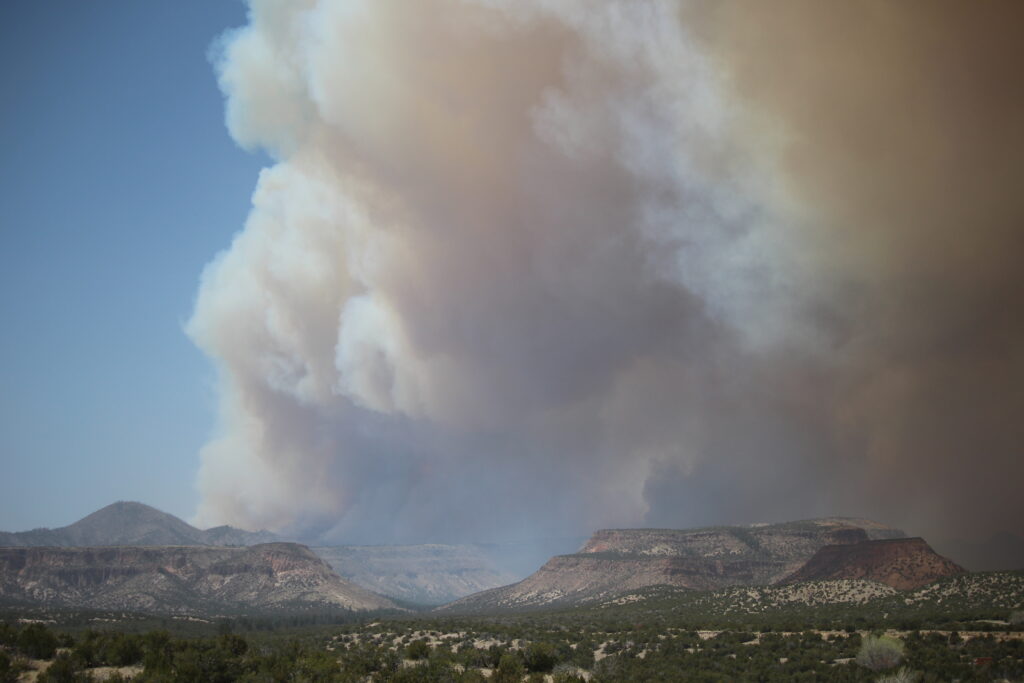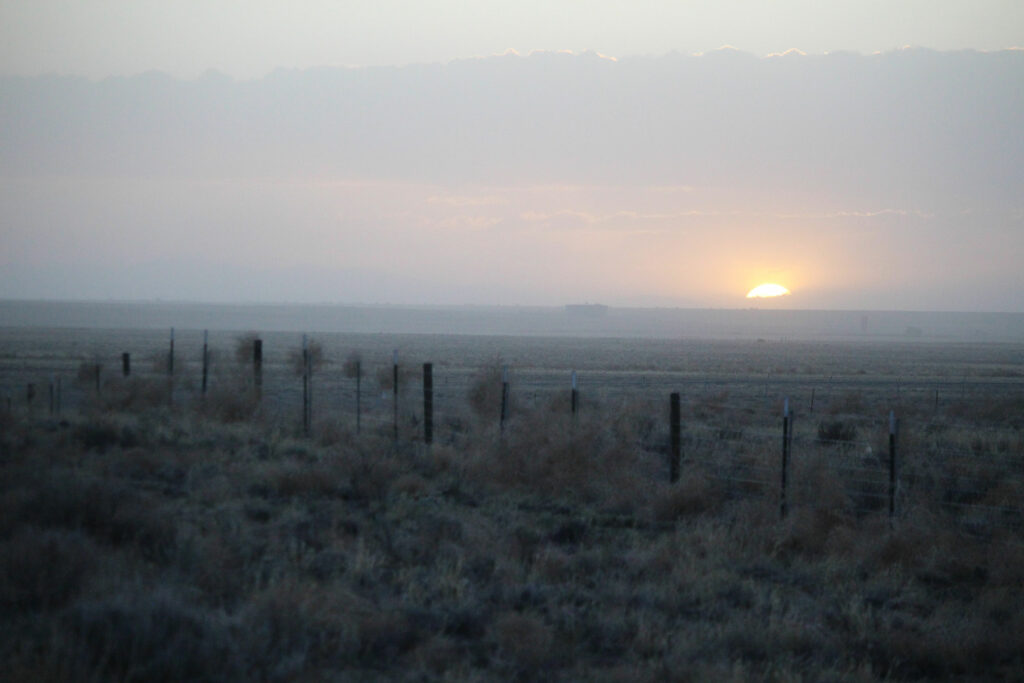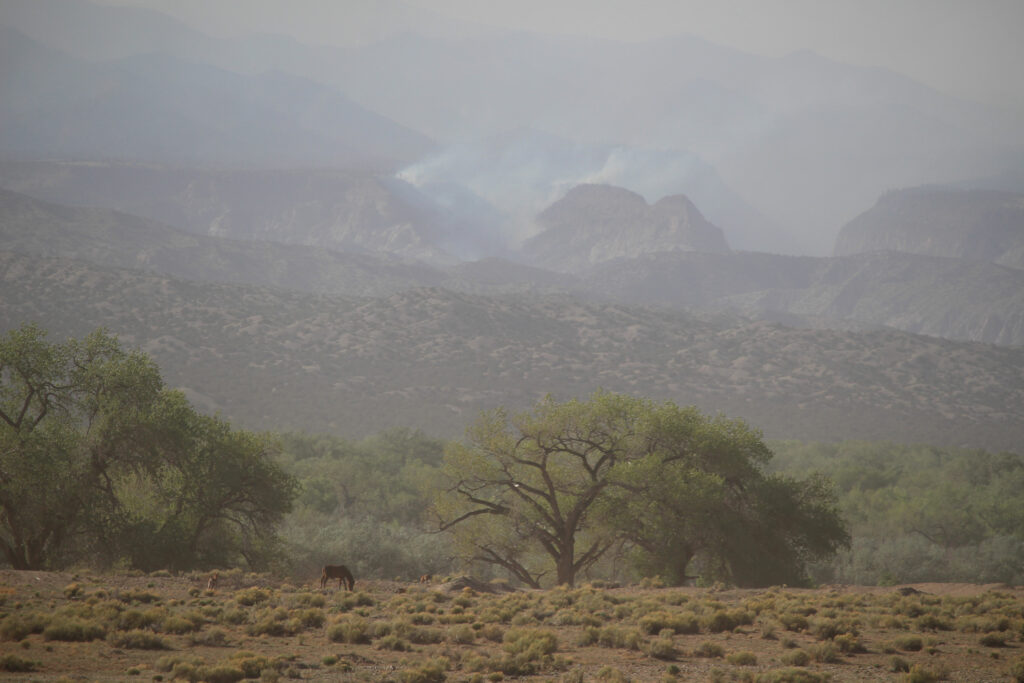Navigating the Cerro Pelado Fire Rumor Mill
Who among us can forget April 2022 in New Mexico?
It was dry. It was hot. It was windy as hell.
Months before the normal start to fire season, there were grass fires, forest fires, and fires along the Rio Grande in both Belen and Albuquerque.
Wildfires raged for months afterwards. But April was a shock.
The Southwest Area Coordination Center’s Southwest Annual Report for 2022 lists 40 “fires of note” in New Mexico last year, 15 of which started in April. According to that report, for Arizona and New Mexico together, “The fire season maintained significant numbers through July but was particularly interesting in that April had the highest number of significant starts.”
April revealed just how much the world had changed. It also showed how ill-equipped we were to deal with a fire season that scientists had been warning about for years—and a season that wildland firefighters knew firsthand was longer, with bigger and scarier fires.
Now, more than a year later, the U.S. Forest Service faces scrutiny for not yet releasing the cause of the Cerro Pelado Fire in the Jemez Mountains. And the federal agency’s lack of communication reveals how little its leadership learned in 2022 about cherishing the public’s trust.

First, let’s take a few minutes to remember just a few of the fires last April…
On April 6, a U.S. Forest Service prescribed fire on the Santa Fe National Forest ran out of control and was declared a wildfire, the Hermit’s Peak Fire.
Six days later, on April 12, high winds knocked down power lines and sparked the Nogal Fire, which burned six homes. That same day, the McBride Fire ignited in Ruidoso. The Nogal Fire was halted at about 400 acres, but McBride spread like mad, burning a quick 7,000 acres, killing two people, and destroying more than 200 homes.
Then on April 19, heat and flame reemerged from a Forest Service pile burn project from January and sparked the Calf Canyon Fire. Three days later, Calf Canyon merged with Hermits Peak to become the largest wildfire in New Mexico history, eventually burning more than 341,000 acres and obliterating almost a thousand homes.
Another fire also ignited on April 22, 2022, that hot, windy Earth Day: the Cerro Pelado Fire in the Jemez Mountains.

Eventually, Cerro Pelado burned 45,605 acres, and though the smoke was regularly visible from Albuquerque, that blaze didn’t hold a candle to the Hermits Peak-Calf Canyon Fire, that behemoth raging outside of Las Vegas, New Mexico.
Even just over a year later, many of us have forgotten—or tried to forget—the chaos of last spring. Fires kept igniting, winds were brutal and relentless, and even with wildland firefighters pouring in from all across the country, federal resources were stretched thin.
As I wrote in a newsletter in early May 2022, while agencies urged the public to rely on official government sources for fire information—rather than unverified social media posts—people complained to me (via Twitter, DMs, emails, and phone calls) that they couldn’t find enough official information about Cerro Pelado.
As the Hermits Peak-Calf Canyon Fire continued to grow, officials were holding Facebook Live briefings and sharing QR codes to evacuation maps.
Meanwhile, people living near the Cerro Pelado Fire were frustrated that community meetings meant to be shared on platforms like Facebook weren’t uploaded until the next day, when the information was already outdated. When I called the listed contact, I twice got someone on the phone who was only assigned to the fire briefly and who couldn’t answer basic questions about the fire (including acreage or evacuations) or the area’s geography.
And at a May public meeting at Cochiti Lake, Jemez Fire Chief Andy Chavez noted that in terms of the Cerro Pelado Fire, “finding support crews and personnel [for communication] has been difficult.”
Thankfully, that fire in the Jemez didn’t explode like Hermits Peak-Calf Canyon, or even the 2011 Las Conchas Fire. In part, that’s because earlier prescribed fire and restoration projects in the Jemez—as well as the burn scar of Las Conchas—kept Cerro Pelado from finding the fuel it needed to really blow up.
But Cerro Pelado still had impacts on people, as well as the landscape and the watershed, that shouldn’t be diminished.

Now, 15 months after the Cerro Pelado Fire ignited, the U.S. Forest Service still hasn’t named its cause, and an Albuquerque law firm is suing the federal agency for not releasing documents under the Freedom of Information Act (FOIA).
The attorneys represent a client who they claim has been “adversely affected” by the federal government’s failure to explain how the fire started. According to the complaint, filed June 14 in U.S. District Court in Albuquerque, the plaintiff needs that information to decide whether additional legal action is warranted.
The legal documents include an appeal the attorneys filed against the agency for failing to fulfill their FOIA requests earlier this year. In that appeal, they write: “In any event, much is already known about the U.S. Forest Service’s ‘secret’ investigation. For example, we know that the investigation is being conducted by the Office of Personnel Management and that it involves an investigation into U.S. Forest Service personnel falsifying statements regarding the origin of the fire, as well as backburning to attempt cover-up.”
Meanwhile, the plaintiff, identified only as TC Company, is run by Terry Conley, who had been an active member of the Southwest Jemez Mountains Resilient Landscapes and Collaborative Forest Landscape Restoration Project.
The goal of that project, which included federal, state, tribal, local, business, and nonprofit partners, was to work toward bringing 210,000 acres of the Jemez Mountains closer to the conditions they experienced before large-scale grazing and a century of fire suppression.
Conley didn’t return phone calls this week (and his attorneys couldn’t answer questions), but in 2017, I wrote about his work in the Jemez:
“I got into the thinning business then but we would just leave it, grind it or burn it. And one of my goals in life was [figuring out] what to do with it because we have to be able to utilize some of this wood,” he said during the meeting. Conley said that the forestry industry in the Jemez disappeared decades ago.
Over the years, Conley has been building a small joint business with the Pueblo of Jemez, Walatowa Timber Industries. Now, there’s a sawmill where crews can bring the small-diameter wood. That’s wood that needs to be removed from the forest, but which isn’t as valuable as the large trees. The mill even has a new building that the Forest Service helped the pueblo build with a matching grant. When it opens up later this spring, that “micromill” will process the residue from the larger mill and make pellets that can also be sold.
“It’s been 20-something years since we had a facility like this in northern New Mexico,” Conley said. “We sell wholesale and retail right out of the yard: pellets, lumber, if we can cut it, we’ll make it for you.”
Conley clearly understands not just the timber industry in the Jemez, but the benefits of cooperation and collaboration—and how things should work with the Forest Service. That said, it’s brazen for the attorneys to have listed under “facts” in the complaint: “The Cerro Pelado Fire started on 4//22/2022 from a prescribed burn by the USFS” without either qualifying or attributing such a sharp allegation.
For more than a year, there have been rumors that Cerro Pelado sparked from a prescribed burn or another type of forest project. Last December, someone identified as Stephanie Haaser posted a Story Map titled “Exploring the Possible Cause of the Cerro Pelado Wildfire” that claims the Pino West burn pile off Forest Road 10, a 300-acre project carried out in January, potentially overlapped with the westernmost extent of the start of the Cerro Pelado Fire in early April. (To find out more about her project, I’ve tried to find Haaser, who has almost no online presence and isn’t known to any of the contacts I’ve reached out to; Stephanie, if you’re out there, drop me a line!)
Then, at the end of June, The Hotshot Wake Up, a Substack newsletter for wildland firefighters, sent out a post, “The Cerro Pelado Fire: Shhhh… It’s a Dirty Little Secret.”
Recently, the Albuquerque Journal reported briefly on the legal complaint, and the editorial board criticized the Forest Service’s lack of transparency.
But the Forest Service still isn’t talking. Or even confirming the existence (or not) of the documents requested by the attorneys. It’s not even clear if the federal agency started investigating the cause of the fire right away—a standard practice whenever communities are threatened—or who conducted the investigation.
With rumors about Cerro Pelado’s origin now spreading beyond just the fire community, last week, I contacted the Santa Fe National Forest, asking who could talk to me about Cerro Pelado. In response, I received an emailed statement that the Forest Service is “very close to finalizing the investigation process” and is “committed to transparency.”
The statement also asked for “patience,” and included this statement, which seems to hint at some answers and suggests an investigation has been done:
“We recognize that conditions on the ground, in particular growing fuel loads, more frequent wind events, and extended drought across the West, have intensified. It’s critical we understand how these changed conditions impact our prescribed fire operations agencywide and we are actively taking steps to incorporate these changes into how prescribed fire is conducted in the Southwest. The investigation on the cause of the Cerro Pelado Fire will also be followed by an internal review which will help the Forest Service minimize future risks by identifying opportunities to improve policies and protocols and to change current standard operating procedures.
We are confident that agency-wide implementation of the immediate recommendations delivered from last year’s National Prescribed Fire program review is also repositioning the Forest Service for the safe and effective use of prescribed fire across the Nation.”
I followed up, asking for the agency to confirm the existence of some of the documents listed in the attorney’s FOIA request—and was told my request was referred to the regional office.
I won’t hold my breath waiting for that answer.
For more than five months last year, I tried to get Forest Service officials from the Santa Fe National Forest, the regional office, or headquarters to come on Our Land to talk about New Mexico’s 2022 fire reason, prescribed fire, and the future of fire and forest management in New Mexico.
The agency offered a number of excuses—they were too busy while the fires were burning; then, they were awaiting guidance from D.C. on a new prescribed fire plan—before officials just stopped responding to my requests.
In response to the Hermits Peak-Calf Canyon Fire, last May the U.S. Forest Service “paused” prescribed fires nationwide. Then in September, it issued a “National Prescribed Fire Program Review” and then last month, the agency released its “National Prescribed Fire Resource Mobilization Strategy.”
But those reports might not offer much comfort to the thousands of New Mexicans harmed by the Hermits Peak-Calf Canyon Fire—or people who suffered damages from fires like Cerro Pelado or the McBride Fire in Ruidoso.
Meanwhile, rumors will keep churning and the Forest Service will probably keep deflecting or ignoring questions from reporters* and the public, a tactic that puts communities at risk, betrays any trust people might have in the agency, and is disrespectful to many of the people working for the agency.
And, while the agency heaves out reports and news releases, the on-the-ground work that needs to be done—in the face of a world growing hotter all the time—will lose momentum and meaning.
Time and again last year, as I interviewed people during the 2022 fire season, even some of the most deep-in-the-weeds-on-climate-change experts I knew were saying things like, “We knew it would be bad. We just didn’t know it could be this bad.”
New Mexico had a reprieve this year from fire season. It could have been a time for reflection and analysis and open communication, a time to rethink all aspects of fire protocol and build trust. But as an institution, the Forest Service doesn’t seem capable of doing that—which makes me dread next year’s fire season even more.
Meanwhile, here’s some of the other news you shouldn’t miss:
• “New Mexico Energy Transition Proposal Would Violate Ban on ‘Fossil Fuel Development’” (Jerry Redfern, Capital & Main)
• “US judge recommends settlement over management of the Rio Grande” (Susan Montoya Bryan, Associated Press)
• “Parched in ‘Podunk,’ New Mexico” (Michael Benanav, Searchlight New Mexico)
• “High water wreaks havoc at Abiquiú, Cochiti recreation areas” (Scott Wyland, Santa Fe New Mexican)
• “NM Supreme Court upholds state regulators’ denial of power plant ownership transfer” (Hannah Grover, New Mexico Political Report)
• “Pueblo community expands broadband reach and plans renewable power” (Jeanette DeDios, KUNM)
• “It’s hot and the late 2023 monsoon season is drying up New Mexico” (Danielle Prokop, Source NM)
• “To Save the Planet, Should We Really be Moving Slower?” (Bill McKibben, The New Yorker)
Lastly, The New Yorker has a piece this week from Jia Tolentino, “What To Do With Climate Emotions.” If you need some help with your climate emotions, you can also revisit the conversation I had last year with Professor Sarah Ray about her book, A Field Guide to Climate Anxiety: How to Keep Your Cool on a Warming Planet.
Because, you know, the Earth just registered its highest land and sea temperatures in recorded history. If you’re not having some climate emotions, you’re not paying attention.
*By the way, I’m happy to be proven wrong on this. Any and all Forest Service officials are welcome to come on the show and answer questions!
P.S. If a friend forwarded you this message, sign up here to receive the newsletter yourself. You can also read recent newsletters online. And if you miss us throughout the week, follow Our Land on Instagram.


